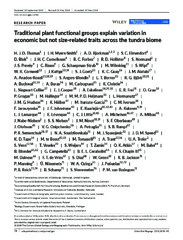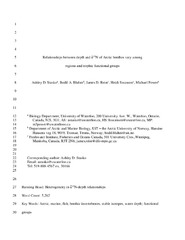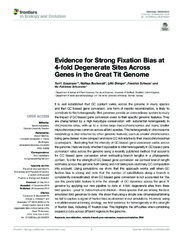Artikler, rapporter og annet (arktisk og marin biologi): Recent submissions
Now showing items 1041-1060 of 1643
-
Traditional plant functional groups explain variation in economic but not size‐related traits across the tundra biome
(Journal article; Tidsskriftartikkel; Peer reviewed, 2018-11-16)<p><i>Aim - </i>Plant functional groups are widely used in community ecology and earth system modelling to describe trait variation within and across plant communities. However, this approach rests on the assumption that functional groups explain a large proportion of trait variation among species. We test whether four commonly used plant functional groups represent variation in six ecologically ... -
Do mothers also "manipulate" grandparental care?
(Journal article; Tidsskriftartikkel; Peer reviewed, 2018-11-15)Paternity uncertainty has proven to be a robust ultimate hypothesis for predicting the higher investment in grandchildren observed among maternal grandparents compared to that of the paternal grandparents. Yet the proximate mechanisms for generating such preferred biases in grandparental investment remain unclear. Here we address two different questions for better understanding the proximate mechanisms ... -
Habitats and movement patterns of white whales Delphinapterus leucas in Svalbard, Norway in a changing climate
(Journal article; Tidsskriftartikkel; Peer reviewed, 2018-10-24)Background: The Arctic is experiencing rapid reductions in sea ice and in some areas tidal glaciers are melting and retracting onto land. These changes are occurring at extremely rapid rates in the Northeast Atlantic Arctic. The aim of this study was to investigate the impacts of these environmental changes on space use by white whales (Delphinapterus leucas) in Svalbard, Norway. Using a unique ... -
Brucella spp. at the wildlife-livestock interface: An evolutionary trajectory through a livestock-to-wildlife "host jump"?
(Journal article; Tidsskriftartikkel; Peer reviewed, 2018-09-18)Brucella infections in wildlife have gained a lot of interest from the scientific community and different stakeholders. These interests are often different and sometimes conflicting. As a result, different management perspectives and aims have been implemented (One Health, public health, veterinary public health, maintenance of a brucellosis free status in livestock, sustainable wildlife harvesting ... -
Relationships between depth and δ15N of Arctic benthos vary among regions and trophic functional groups
(Journal article; Tidsskriftartikkel, 2018-03-27)Stable isotope ratios of nitrogen (δ<sup>15</sup>N) of benthic primary consumers are often significantly related to water depth. This relationship is commonly attributed to preferential uptake of <sup>14</sup>N from sinking particulate organic matter (POM) by microbes, and suggests that relationships between δ<sup>15</sup>N and water depth may be affected by local POM sources and flux dynamics. ... -
Evidence for Strong Fixation Bias at 4-fold Degenerate Sites Across Genes in the Great Tit Genome
(Journal article; Tidsskriftartikkel; Peer reviewed, 2018-11-29)It is well established that GC content varies across the genome in many species and that GC biased gene conversion, one form of meiotic recombination, is likely to contribute to this heterogeneity. Bird genomes provide an extraordinary system to study the impact of GC biased gene conversion owed to their specific genomic features. They are characterized by a high karyotype conservation with ... -
Asynchronous Accumulation of Organic Carbon and Nitrogen in the Atlantic Gateway to the Arctic Ocean
(Journal article; Tidsskriftartikkel; Peer reviewed, 2018-11-15)Nitrogen (N) is the main limiting nutrient for biological production in the Arctic Ocean. While dissolved inorganic N (DIN) is well studied, the substantial pool of N bound in organic matter (OM) and its bioavailability in the system is rarely considered. Covering a full annual cycle, we here follow N and carbon (C) content in particulate (P) and dissolved (D) OM within the Atlantic water inflow to ... -
Long-term responses of zooplankton to invasion by a planktivorous fish in a subarctic watercourse
(Journal article; Tidsskriftartikkel; Peer reviewed, 2008-08-13)<p>1. Introduced or invading predators may have strong impacts on prey populations of the recipient community mediated by direct and indirect interactions. The long‐term progression of predation effects, covering the invasion and establishment phase of alien predators, however, has rarely been documented.</p> <p>2. This paper documents the impact of an invasive, specialized planktivorous fish ... -
A screening for canine distemper virus, canine adenovirus and carnivore protoparvoviruses in Arctic foxes (Vulpes lagopus) and red foxes (Vulpes vulpes) from Arctic and sub-Arctic regions of Norway
(Journal article; Tidsskriftartikkel; Peer reviewed, 2018-10-26)Canine distemper virus (CDV), canine adenovirus (CAdV) and canine parvovirus type 2 (CPV-2) cause disease in dogs (Canis familiaris). These, or closely related viruses, may also infect wild carnivores. The aim of this study was to investigate exposure to CDV, CAdV and CPV-2 among fox populations in Norway. Arctic foxes (n = 178) from High-Arctic Svalbard were investigated for antibodies against CDV. ... -
Benthic-pelagic trophic coupling in an Arctic marine food web along vertical water mass and organic matter gradients
(Journal article; Tidsskriftartikkel; Peer reviewed, 2018-04-26)Understanding drivers of benthic-pelagic coupling in Arctic marine ecosystems is key to identifying benthic areas that may be sensitive to climate-driven changes in hydrography and surface production. We coupled algal biomass and sedimentary characteristics with stable isotope data for 113 fishes and invertebrates in the Canadian Beaufort Sea and Amundsen Gulf to examine how trophic structure was ... -
Tundra Trait Team: A database of plant traits spanning the tundra biome
(Journal article; Tidsskriftartikkel; Peer reviewed, 2018-10-22)<p><i>Motivation</i>: The Tundra Trait Team (TTT) database includes field‐based measurements of key traits related to plant form and function at multiple sites across the tundra biome. This dataset can be used to address theoretical questions about plant strategy and trade‐offs, trait–environment relationships and environmental filtering, and trait variation across spatial scales, to validate satellite ... -
Developing an observational design for epibenthos and fish assemblages in the Chukchi Sea
(Journal article; Tidsskriftartikkel; Peer reviewed, 2018-11-14)In light of ongoing, and accelerating, environmental changes in the Pacific sector of the Arctic Ocean, the ability to track subsequent changes over time in various marine ecosystem components has become a major research goal. The high logistical efforts and costs associated with arctic work demand the prudent use of existing resources for the most comprehensive information gain. Here, we compare ... -
High goose abundance reduces nest predation risk in a simple rodent-free high-Arctic ecosystem
(Journal article; Tidsskriftartikkel; Peer reviewed, 2017-12-13)Breeding geese are the preferred prey of the Arctic fox Vulpes lagopus in the high-Arctic Svalbard archipelago. According to the <i>apparent competition hypothesis (ACH)</i>, less-abundant prey species (e.g. ptarmigan, waders and small passerines) will experience higher predation rates when breeding in association with the more common prey (geese), due to spill-over predation by the shared predator. ... -
Quantifying individual heterogeneity and its influence on life-history trajectories: different methods for different questions and contexts
(Journal article; Tidsskriftartikkel; Peer reviewed, 2017-09-25)Heterogeneity among individuals influences the life‐history trajectories we observe at the population level because viability selection, selective immigration and emigration processes, and ontogeny change the proportion of individuals with specific trait values with increasing age. Here, we review the two main approaches that have been proposed to account for these processes in life‐history trajectories, ... -
Trait-based approaches in rapidly changing ecosystems: A roadmap to the future polar oceans
(Journal article; Tidsskriftartikkel; Peer reviewed, 2018-04-30)Polar marine regions are facing rapid changes induced by climate change, with consequences for local faunal populations, but also for overall ecosystem functioning, goods and services. Yet given the complexity of polar marine ecosystems, predicting the mode, direction and extent of these consequences remains challenging. Trait-based approaches are increasingly adopted as a tool by which to explore ... -
Ecological stoichiometry and nutrient partitioning in two insect herbivores responsible for large-scale forest disturbance in the Fennoscandian subarctic
(Journal article; Tidsskriftartikkel; Peer reviewed, 2018-10-04)<p>1. Outbreaks of herbivorous insects can have large impacts on regional soil carbon (C) storage and nutrient cycling. In northernmost Europe, population outbreaks of several geometrid moth species regularly cause large‐scale defoliation in subarctic birch forests. An improved understanding is required of how leaf C and nutrients are processed after ingestion by herbivores and what this means for ... -
Haul-out behaviour of Arctic ringed seals (Pusa hispida): inter-annual patterns and impacts of current environmental change
(Journal article; Tidsskriftartikkel; Peer reviewed, 2018-01-27)Hauling out onto a solid substrate is an integral part of most pinnipeds’ activity budgets. Ringed seals (<i>Pusa hispida</i>) are an Arctic species that hauls out on sea ice routinely throughout the year. In 2006, a sudden change in the sea-ice regime occurred in Svalbard (Norway). Amongst other changes, the amount of land-fast ice declined sharply. This study examined the intra- and inter-annual ... -
Concomitant Temperature Stress and Immune Activation may Increase Mortality Despite Efficient Clearance of an Intracellular Bacterial Infection in Atlantic Cod
(Journal article; Tidsskriftartikkel; Peer reviewed, 2018-11-04)The environmental temperature has profound effects on biological systems of marine aquatic organisms and plays a critical role in species distribution and abundance. Particularly during the warmer seasons, variations in habitat temperature may introduce episodes of stressful temperatures which the organisms must adapt to and compensate for to maintain physiological homeostasis. The marine environment ... -
How can a binary switch within the pars tuberalis control seasonal timing of reproduction?
(Journal article; Tidsskriftartikkel; Peer reviewed, 2018-10)Life in seasonally changing environments is challenging. Biological systems have to not only respond directly to the environment, but also schedule life history events in anticipation of seasonal changes. The cellular and molecular basis of how these events are scheduled is unknown. Cellular decision-making processes in response to signals above certain thresholds regularly occur i.e. cellular fate ... -
Human long intrinsically disordered protein regions are frequent targets of positive selection
(Journal article; Tidsskriftartikkel; Peer reviewed, 2018-06-01)Intrinsically disordered regions occur frequently in proteins and are characterized by a lack of a well-defined three-dimensional structure. Although these regions do not show a higher order of structural organization, they are known to be functionally important. Disordered regions are rapidly evolving, largely attributed to relaxed purifying selection and an increased role of genetic drift. It has ...


 English
English norsk
norsk


















